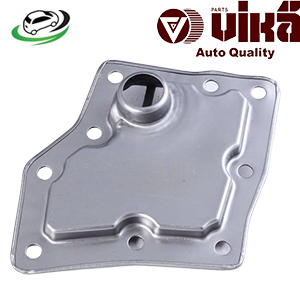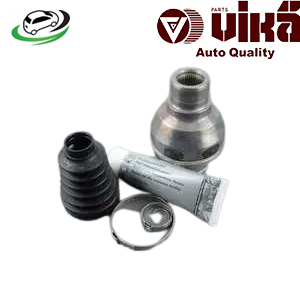Get VW Tiguan 2.0L A/T AWD/ Tiguan 2.0L A/T FWD/ Tiguan 2.0L M/T Inner Joint Assembly 5N0498103X
The inner joint assembly, also known as the inner Constant Velocity (CV) joint assembly, is a crucial component in a vehicle’s drivetrain system. It plays a vital role in transferring power from the engine and transmission to the wheels, allowing the vehicle to move. This component is responsible for ensuring smooth and flexible power transmission, even when the wheels are turning or the suspension is moving. Understanding how the inner joint assembly works, its benefits, and the importance of proper maintenance can help extend the life of a vehicle and enhance overall performance.
In this comprehensive article, we’ll explore the function of the inner joint assembly, its components, the benefits it provides to the vehicle, signs of wear and failure, and how to maintain it properly.
1. Overview of the Drivetrain and Inner Joint Assembly
The drivetrain in a front-wheel-drive (FWD), rear-wheel-drive (RWD), or all-wheel-drive (AWD) vehicle consists of several components that work together to transfer power from the engine to the wheels. These include the transmission, differential, driveshafts, and CV joints. The inner joint assembly is specifically found in front-wheel-drive and all-wheel-drive vehicles.
The inner joint connects the driveshaft (half shaft) to the transmission or differential. Together with the outer CV joint, it allows the axle to bend while maintaining a smooth transfer of power at varying angles. This flexibility is essential when the vehicle is turning or when the suspension is absorbing bumps in the road, ensuring a smooth ride and uninterrupted power delivery.
2. Components of the Inner Joint Assembly
The inner joint assembly is a relatively complex component made up of several parts designed to allow the driveshaft to flex and transmit power smoothly. Key components include:
- Housing: The metal casing that houses the internal components of the inner joint. It connects the driveshaft to the transmission and provides a secure enclosure for the joint’s moving parts.
- Inner Race: This part sits inside the housing and is connected to the driveshaft. The inner race features grooves where the bearings are located.
- Bearings: These are small, hardened steel balls that roll within the grooves of the inner race and housing. The bearings allow the inner race to move smoothly within the housing, even when the axle is bending.
- Cage: The cage holds the bearings in place, allowing them to rotate freely. It ensures that the bearings remain aligned and evenly spaced to facilitate smooth movement.
- Boot: A flexible rubber boot that covers the joint to protect it from dirt, debris, and moisture. The boot is crucial for keeping the joint lubricated and free from contaminants that could cause wear.
3. Function of the Inner Joint Assembly
The inner joint assembly’s primary function is to allow flexibility in the driveshaft while transmitting torque from the transmission to the wheels. It ensures that the driveshaft can move and bend as the suspension and steering components move. Here’s a breakdown of its functions:
A. Allowing Axial Movement
The inner joint assembly permits axial movement of the driveshaft, which is necessary for changes in the vehicle’s suspension height. For example, when a vehicle goes over a bump, the wheels move up and down relative to the chassis. The inner joint compensates for this movement by allowing the driveshaft to change length slightly while still transmitting power.
B. Transmitting Torque
The inner joint ensures that torque (rotational force) is transferred from the engine and transmission to the wheels, even when the driveshaft is at an angle. This allows the wheels to turn while the engine’s power is transmitted to the wheels, propelling the vehicle forward or backward.
C. Maintaining Constant Velocity
The term “constant velocity” refers to the joint’s ability to maintain a uniform rotational speed between the transmission and the wheels, regardless of the angle of the driveshaft. This prevents the vibrations and pulsations that can occur with older or less advanced joints, ensuring smooth and efficient power delivery.
4. Benefits of the Inner Joint Assembly
The inner joint assembly provides several benefits to the vehicle, contributing to a smoother driving experience and enhancing performance.
A. Smooth Power Transmission
One of the primary benefits of the inner joint assembly is its ability to transmit power smoothly, even when the vehicle is turning or going over uneven terrain. The flexible nature of the joint ensures that the engine’s power is delivered to the wheels without interruption or vibration, which enhances both performance and ride quality.
B. Improved Steering and Handling
The flexibility provided by the inner joint assembly allows the front wheels to turn and move independently while still receiving power from the transmission. This improves steering and handling, particularly in front-wheel-drive and all-wheel-drive vehicles, where the front wheels need to manage both power delivery and steering.
C. Vibration Reduction
The constant velocity design of the inner joint assembly reduces vibrations that can be transmitted through the drivetrain. By maintaining uniform rotational speed, the joint prevents the shuddering or pulsations that could otherwise be felt in the steering wheel or floorboard during acceleration or cornering.
D. Enhanced Durability
Modern inner joint assemblies are designed to be durable and capable of withstanding the stresses of daily driving. They are made from high-quality materials that resist wear and tear, providing long-lasting performance when properly maintained.
5. Common Issues and Symptoms of Failure
Over time, the inner joint assembly can wear out, especially if it’s not properly maintained. Here are some common issues and symptoms of failure:
A. Worn or Torn CV Boot
The rubber boot that protects the inner joint is vulnerable to wear and tear. If the boot becomes torn, dirt, debris, and moisture can enter the joint, causing the bearings and other components to wear out prematurely. A torn boot is often the first sign of an impending inner joint failure.
B. Clicking or Popping Noises
One of the most common signs of a failing inner joint assembly is a clicking or popping noise when turning. This occurs when the bearings inside the joint become worn or damaged, causing uneven movement and creating noise as the axle bends during a turn.
C. Vibration During Acceleration
A worn or damaged inner joint assembly can cause vibrations that are felt through the steering wheel or the vehicle’s floor. These vibrations are often most noticeable during acceleration and can indicate that the joint is no longer maintaining constant velocity.
D. Grease Leaks
If the CV boot is damaged, grease from inside the joint may leak out. This can usually be seen as grease splattered around the wheel well or suspension components. A lack of lubrication can cause the joint to wear out quickly and fail.
E. Loss of Power or Acceleration
In extreme cases, a completely failed inner joint assembly can cause the vehicle to lose power or experience difficulty accelerating, as the joint can no longer transmit torque effectively.
6. Maintenance and Care of the Inner Joint Assembly
Proper maintenance of the inner joint assembly is essential to ensuring its long life and preventing costly repairs. Here are some key maintenance tips:
A. Regular Inspection of the CV Boot
One of the most important maintenance tasks is to regularly inspect the CV boot for signs of wear, cracks, or tears. A damaged boot should be replaced immediately to prevent contaminants from entering the joint and causing damage.
B. Lubrication
The inner joint assembly requires lubrication to function properly. The grease inside the boot helps reduce friction and wear. If the boot is damaged and grease leaks out, it’s important to have the joint inspected and re-lubricated.
C. Addressing Noises Early
If you hear clicking, popping, or other unusual noises while turning, it’s important to have the inner joint assembly inspected by a professional. Early detection of worn or damaged components can prevent more severe damage and save you money on repairs.
D. Avoiding Rough Terrain and Aggressive Driving
While inner joint assemblies are designed to handle the stresses of daily driving, rough terrain, or aggressive driving can put additional strain on the joints. Avoiding potholes, off-road conditions, or aggressive cornering can help extend the life of the inner joint assembly.
E. Timely Replacement
If the inner joint assembly becomes worn or damaged beyond repair, it’s important to have it replaced promptly. A failing inner joint can cause further damage to other drivetrain components, leading to more expensive repairs.
7. Conclusion
The inner joint assembly is a critical component in a vehicle’s drivetrain, enabling smooth power transmission while allowing the front wheels to turn and the suspension to move freely. By maintaining proper alignment and constant velocity, the inner joint ensures efficient power delivery and a smooth ride. Regular maintenance, including inspecting the CV boot and addressing any unusual noises or vibrations, can help extend the life of the inner joint assembly and keep your vehicle running smoothly. Understanding the function, benefits, and common issues associated with the inner joint assembly allows drivers to take proactive steps to maintain their vehicles and avoid costly repairs.
Follow us on Facebook for more parts.




Reviews
Clear filtersThere are no reviews yet.